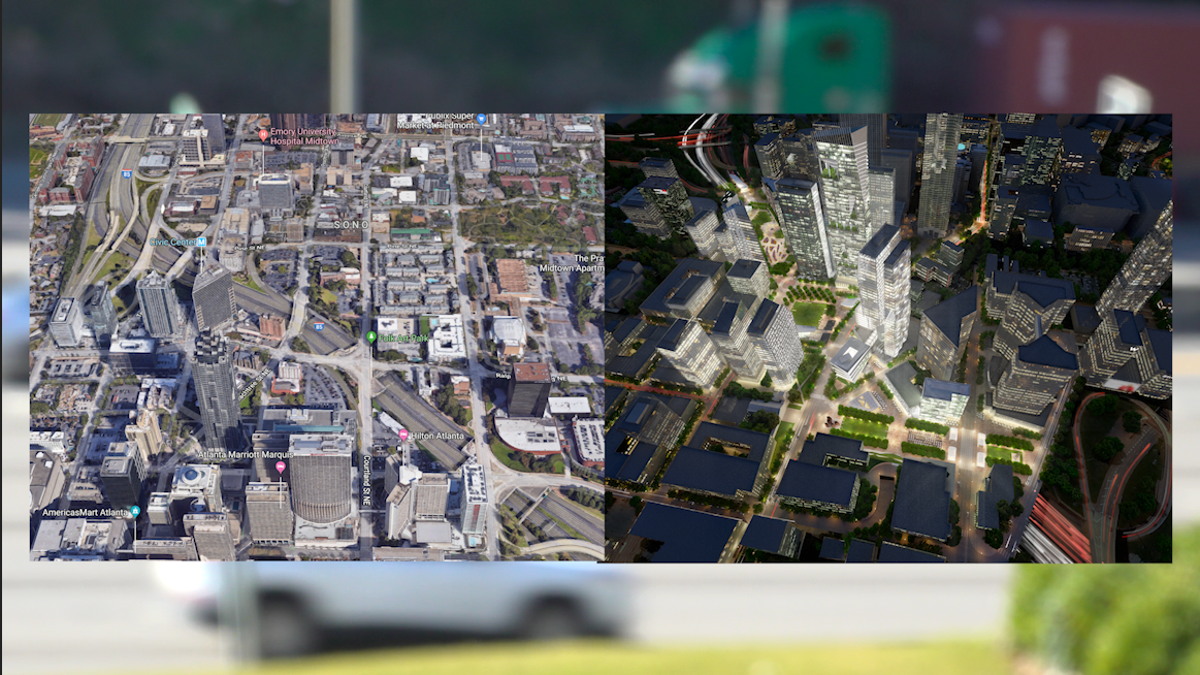ATLANTA – Georgia’s capital city Downtown Connector is considered one of the most blood-boiling traffic funnels in the country, with hundreds of thousands of vehicles inching along a roughly 14-lane interstate during rush hour. Yet, people are pushing to add traffic to these notoriously strapped roadways.
Foot traffic, that is.
Several proposals in Atlanta suggest building greenery covers over sections of interstates – dubbed “hanging gardens,” or most frequently, “deck parks.”

Project officials aim to "stitch" downtown Atlanta and surrounding areas together with a deck park covering a section of I-75/I-85.
ATLANTA’S UNPRECEDENTED SUBWAY SOCCER FIELD GETTING GLOBAL ATTENTION
“We’re essentially filling in a hole over a highway,” said A.J. Robinson, president of Central Atlanta Progress. The non-profit introduced its initial concept design of a deck park in 2016 but claims progress is picking up with an expected completion of its $1 million feasibility study in the next few weeks.
The project, nicknamed the Stitch, would cap a three-quarter-mile strip of the Downtown Connector (I-75/I-85 freeways) from the Civic Center MARTA Station to Piedmont Avenue. Between new park space, eateries, retail and residential areas, project proponents estimate it would generate $21 to $58 million in new revenue.
“You have to think of your favorite neighborhood park,” Robinson told Fox News above the sounds of horns and purring engines. “That’s what we’re trying to do here…festivals, gatherings, picnics, throwing a Frisbee.”

One proposal in Buckhead would create a 9-acre park on top of GA-400 for an estimated $250 million.
Also in the midst of a feasibility study is a slightly smaller proposal in Buckhead – a half-mile park that would span across GA400.
Both projects address connectivity issues, originating from the construction of highways (many in the mid-20th Century) splicing through communities; hence the Stitch’s name – for stitching downtown Atlanta back together with the surrounding community.
“It’s hard to envision in this particular space, but it can happen and it has happened in other cities,” Robinson said.
Dallas appears to have triggered a domino effect after it opened Klyde Warren Park over a recessed freeway in 2012, receiving more than 6 million visitors since. The park provides daily free programming, ranging from yoga classes to lectures and concerts.
Lead designer Jim Burnett said more than 30 cities are currently considering similar designs.

More than 30 cities in the U.S. are seriously considering developing deck parks, according to OJB Landscape Architecture.
Burnett said the sudden influx of interest in deck parks is two-fold.
“It’s very hard to put together five acres in and near the core of many U.S. cities, so to have this ability to kind of create a new public open space…is a very positive thing,” Burnett said, and two “as the demand and the resurgence of people moving back to cities become more significant, public open space is also significant.”
Dr. Jean-Paul Addie, assistant professor of urban studies at Georgia State University, pointed to the mad dash for Amazon HQ2 as a microcosmic example of who cities are targeting nowadays and how they are luring them.
He said dozens of cities, including Atlanta, attempted (and continue to attempt) to woo “what Richard Florida would call the ‘creative class’ – higher educated, tech-savvy millennials [who] are looking for cities that are walkable” – the very thing deck parks help provide.
But the cost of appealing to the younger population is high.

Cars pass under and beside Dallas' Klyde Warren Park.
CES 2019: 7 TECHNOLOGIES THAT WILL LEAVE YOU A LITTLE SPEECHLESS
Dallas funded its $110 million park through a combination of federal, state and city money along with private donations. The Stitch carries a $300 million price tag and the Park over GA400 is attached to a $250 million one.
Critics say these deck parks displace valuable state and federal funds from more pressing infrastructural needs like roadway maintenance, public transit and affordable housing.
“Building a nice, large piece of infrastructure like this is always appealing on a political cycle […but] if this sits in an ocean of auto-mobility, what are we really accomplishing in terms of a making Atlanta a livable, walkable, vibrant community?” Addie asked.
He suggested Atlanta won’t see the same success as other high-density cities with deck parks because it doesn’t share the same critical mass of activities downtown. Thus, Addie argued, while a deck park could be a nice spot to drive to every once in a while, there won’t be a steady flow of crowds without a more pedestrian-friendly infrastructure citywide.
“If you look out the window here, you don’t see streets filled with pedestrians,” Addie said. “So, while we can aspire to have a walkable city, I think we need to be realistic in terms of where people are walking and why they’re going to be walking there.”


